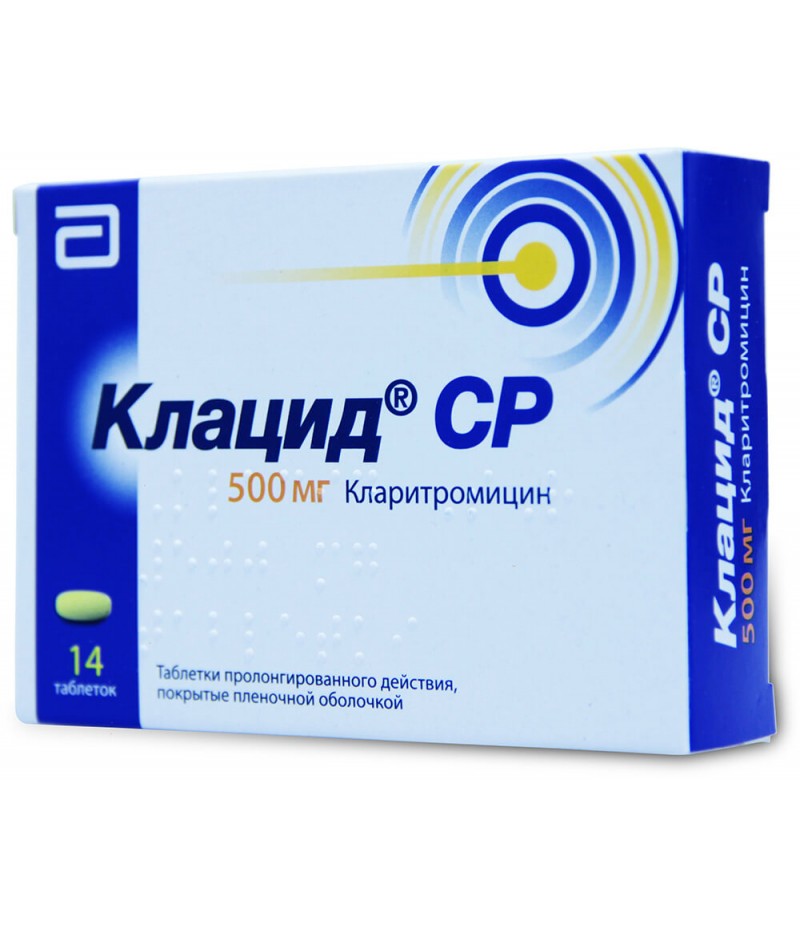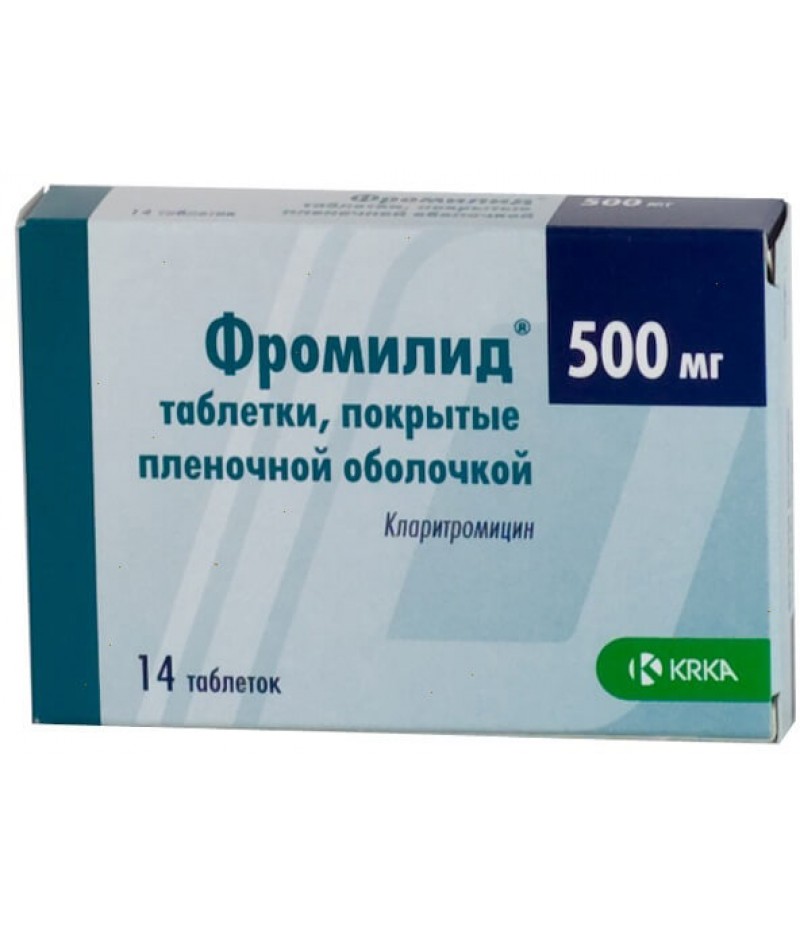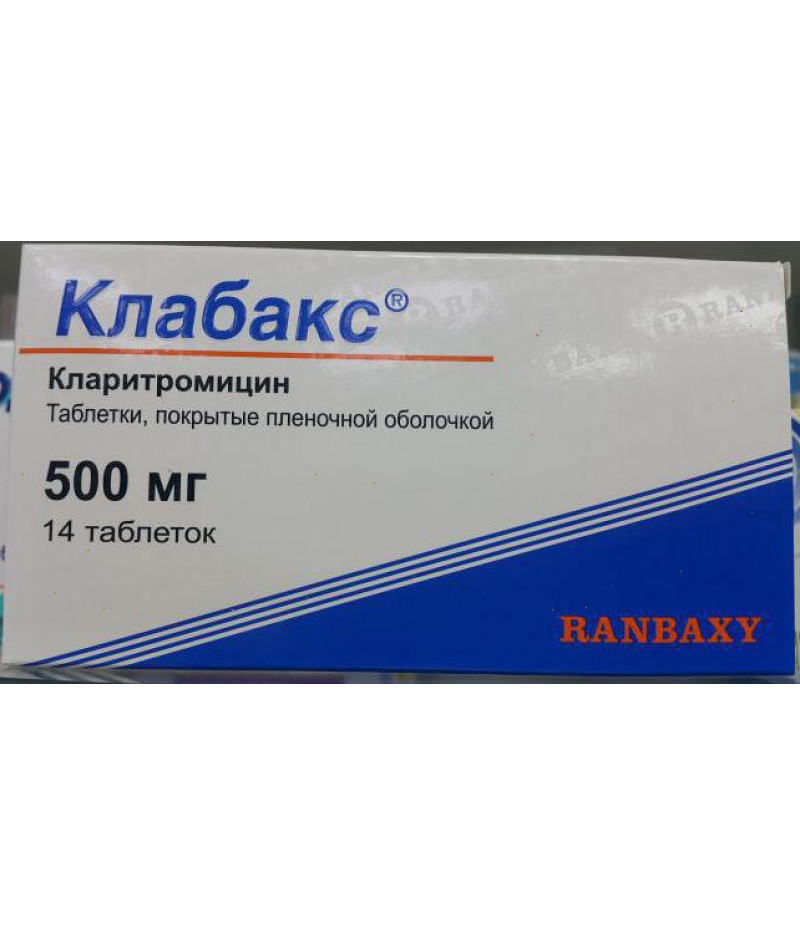Klacid tabs 500mg #14
- $39.39
- 3 or more $38.30
- Availability:In Stock
Klacid instruction to useReed more and buy Klacid on this pageCompositionAntibiotic Klacid contains the active ingredient of clarithromycin, as well as additional components: sodium calcium alginate, sodium alginate, lactose, hydr..
Tags: tabs
Klacid instruction to use
Reed more and buy Klacid on this page
Composition
Antibiotic Klacid contains the active ingredient of clarithromycin, as well as additional components: sodium calcium alginate, sodium alginate, lactose, hydrophosphate anhydrous citric acid, stearic acid, povidone KZO, magnesium stearate.
Form of issue
Klacid 500 mg and 250 mg is produced in the form of tablets, which covers the shell of yellow color. Tablets are oval in shape, according to the cut, there are two layers: a yellow film and a whitish core. In a blister made of foil, 7, 10 or 14 tablets can be placed, 1, 2 or 3 such blisters are packaged in a cardboard box.
pharmachologic effect
The active substance of clarithromycin is included in the group of macrolides, semisynthetic antibiotics. Antibacterial effect is produced by suppression of protein synthesis of bacteria. The consistency of the tablet is such that the active ingredient is released gradually, during the passage of the preparation through the gastrointestinal tract. Clarithromycin is active against isolated and standard cultures of bacteria. A high effect is observed when using an agent for the treatment of legionnaire disease, pneumonia of mycoplasmal etiology. Gram-negative bacteria do not show sensitivity to clarithromycin.
The active substance acts as an antibacterial agent against Group A streptococci, pneumococcus, Staphylococcus aureus, microorganisms, pathogens of hemophilia, listeriosis, gonorrhea, pneumonia, pneumoclamidosis, leprosy, chlamydia, erysipelas, sporotrichosis.
Those pathogens that do not exhibit sensitivity to Oxacillin and Methicillin are also resistant to the effects of clarithromycin.
There was also a positive effect of clarithromycin in relation to the following microorganisms (efficacy and safety not confirmed in clinical trials): green streptococcus, peptococcus, group B, C, F, G streptococci; causative agents of pasteurellosis of birds, whooping cough, human toxicological infections, acne, borrelliosis, syphilis, enterocolitis.
In the process of the metabolism of clarithromycin, the body releases active 14-hydroxyclarithromycin, which shows microbiological activity. Metabolism occurs in the human liver. If a person took the drug regularly, there was no increase in the activity of his influence.
Pharmacokinetics and pharmacodynamics
The substance clarithromycin binds to blood proteins well. The highest concentration of the drug is determined for 6 hours. The larger the dose of the drug the patient took, the more prolonged the period of time it is excreted from the body. The amount of metabolite (14-hydroxyclarithromycin) does not increase in parallel with an increase in the dose of clarithromycin. The larger is the accepted dose of Klacid, the less 14-hydroxyclorithromycin is formed in the body.
From the body, the drug is excreted through the kidneys and intestines (respectively, 40% and 30% of the dose). After oral administration of clarithromycin, and its metabolite is distributed to tissues and body fluids, in tissues, as a rule, contains twice as much drug as serum.
No dosage adjustment is needed for liver disease. With kidney diseases, the withdrawal of clarithromycin from the body increases. Also, the withdrawal period of the drug is increased in elderly people.
Indications for use
The use of Klacid is indicated in the following diseases and conditions:
infectious diseases of the respiratory tract, lower divisions (pneumonia, bronchitis, etc.);
infectious diseases of the respiratory tract, upper divisions (with angina, sinusitis, pharyngitis, etc.);
infectious lesions of soft tissues, skin (folliculitis, erysipelas, etc.);
Mycobacterial infections that provoked Mycobacterium intracellulare and Mycobacterium avium;
infections, provoked by Mycobacterium fortuitum, Mycobacterium chelonae, Mycobacterium kansasii.
Also, the drug is taken to prevent infection, provoked by the complex Mycobacterium avium (MAC). It is prescribed to reduce the incidence of relapses of duodenal ulcers.
Contraindications
You can not take an antibiotic in the following cases:
at a high sensitivity of the organism to the means of the group of macrolides;
with porphyria;
during pregnancy and lactation;
children up to 3 years of age.
Caution means is prescribed for violations of kidney and liver.
You can not at the same time take clarithromycin and such medicines: Terfenadine, cisapride, dihydroergotamine, Pimozide, Ergotamine, Astemizol.
Side effects
If Intravenous Klacid is given or an oral administration of the agent is carried out, a number of side effects may occur. If such effects occur after intravenous administration or ingestion of tablets, it is necessary to inform the specialist about this. The following manifestations are possible:
Functions of the central nervous system: a change in taste, headaches.
The digestive system: nausea, abdominal pain, diarrhea, vomiting, indigestion.
Local reactions when the solution is administered: inflammatory processes at the injection site, phlebitis, pain during palpation.
Laboratory indicators: an increase in the activity of liver enzymes.
In addition to these side effects, side effects are possible, which are less frequent:
candidiasis of the oral cavity;
thrombocytopenia, leukopenia;
anaphylactic reactions;
hypoglycemia;
mental disorders, insomnia;
dizziness, convulsions;
myalgia;
reversible hearing loss;
ventricular tachycardia;
stomatitis, acute pancreatitis, glossitis;
abnormal liver function;
urticaria, rash;
increased content of creatinine in the blood.
Instructions for use Klacid (Method and dosage)
Instruction for the use of Klacid for children and adults provides for taking the medication inside, regardless of the meal.
Adult patients receive 250 mg of clarithromycin twice a day. If treatment of serious diseases, mycobacterial infections, is carried out, the dose can be increased to 500 mg twice a day. In most cases, treatment lasts from 5 to 14 days.
If a suspension of Klacid is prescribed for treatment, the instructions for use should be strictly observed. Suspension is prescribed for treatment of children, it can be taken regardless of food intake, can be taken with milk. To prepare for use the suspension, you need to gradually add water to the label in the vial, then shake it. In 5 ml of a 60 ml suspension contains 125 mg of clarithromycin; in 5 ml of a suspension of 100 ml contains 250 mg of clarithromycin. The suspension can be stored for two weeks at room temperature.
Before you give antibiotic Klacid to children, you need to shake the suspension thoroughly. In a day, it is recommended that children be administered a dose of 7.5 mg per 1 kg of body weight twice a day. The maximum allowable dose is 500 mg twice a day. Therapy can last from 5 to 10 days.
Overdose
When taking very large doses of this drug, patients may show signs of impaired functioning of the digestive system. It is important to remove as soon as possible the remnants of the drug from the digestive tract, after which symptomatic treatment is performed.
Interaction
Categorically, the combined use of clarithromycin and astemizole, Pimozide, Terfenadine, Cisapride preparations is not allowed, since in this case, serious side effects are likely to develop. In particular, the occurrence of cardiac arrhythmias, including ventricular fibrillation, ventricular tachycardia, is possible.
With the simultaneous use of clarithromycin and Ergotamine or Dihydroergotamine, acute poisoning with a group of ergotamines is likely. In particular, limb ischemia, vascular spasm, etc. can occur. Simultaneous reception of clarithromycin and ergot alkaloids is not allowed.
CYP3A inducers induce the metabolism of clarithromycin. As a consequence, the concentration of clarithromycin decreases and its effectiveness. If clarithromycin and Rifabutin are used concurrently, plasma rifabutin concentration increases and clarithromycin concentration decreases.
Preparations Nevirapine, Efavirenz, Rifabutin, Rifapentin can accelerate the metabolism of clarithromycin, thereby reducing its concentration in the plasma and increasing the concentration of its metabolite - 14-OH-clarithromycin. As a consequence, therapeutic efficacy may decrease.
A decrease in the concentration of clarithromycin is noted when it is administered together with etravirine.
It is necessary to adjust the dose of drugs with the joint administration of clarithromycin and ritonavir.
With simultaneous treatment with Klacid and oral hypoglycemic drugs or insulin, there may be severe hypoglycemia. You should constantly monitor the glucose level.
With the simultaneous administration of an antibiotic with quinidine, disopyramide, ventricular tachycardia is possible.
With care, it is necessary to take clarithromycin for those who receive drugs - substrates of the isoenzyme CYP3A, as well as in combination with statins.
Contraindicated concurrent treatment with clarithromycin and simvastatin.
It is important to monitor the patient's condition with co-treatment with warfarin and clarithromycin because of the possibility of bleeding.
With the joint administration of clarithromycin and tadalafil, sildenafil, vardenafil, there is a need to reduce the dosage of the last drugs.
Simultaneous treatment with antibiotics and theophylline or carbamazepine leads to an increase in the concentration of these drugs in the bloodstream.
With the use of clarithromycin and triazolam, the effect on the central nervous system, as a consequence, develops drowsiness and confusion.
It is impossible at the same time to take clarithromycin and colchicine in people who have impaired liver or kidney function.
With the simultaneous treatment of clarithromycin and digoxin, the effect of the latter is enhanced. It is necessary to constantly monitor the level of digoxin in the blood serum.
There is a bi-directional effect of drugs with concurrent administration of clarithromycin and atazanavir, as well as clarithromycin and itraconazole, clarithromycin and saquinavir.
When treating simultaneously with antibiotic and amlodipine, verapamil, diltiazem, the probability of developing arterial hypotension increases.
Storage conditions
It is necessary to protect the antibiotic from children's access, it should be stored at a temperature of no higher than 30 ° C.
Shelf life - 3 years.
special instructions
People with liver disease may experience changes in serum enzyme indices, which should be carefully prescribed.
Cautiously assigned to people taking other medications in parallel, which are metabolized by the liver.
With prolonged treatment with antibiotics, it is possible to form colonies with a large number of insensitive fungi and bacteria.
With chronic liver disease, you need to regularly monitor serum enzymes.
Possible manifestation of pseudomembranous colitis when treated with an antibiotic. It is also possible to change the normal intestinal microflora.
Care should be given to medication for people, severe heart failure, bradycardia, hypomagnesemia. It is necessary to constantly monitor the ECG, determining the increase in the QT interval.
It is possible to increase the symptoms of myasthenia gravis in people who take clarithromycin.
Powder for the suspension of Klacid contains sucrose, which should be taken into account for people suffering from diabetes.
When treating clarithromycin, you need to carefully manage the transport and perform actions that require high concentration of attention.
With alcohol
As the instruction indicates, Klacid and alcohol are incompatible. If a patient consumes alcohol while treating this antibiotic, the risk of side effects increases dramatically, as the toxicity of the drug increases dramatically.
Klacid for children
Klacid for children can be used from the age of three. In most cases, children are prescribed Klacid suspension. Reviews for children suggest that this drug is quite effective. The price of the suspension is quite high. Dosage for children is as follows: 7.5 mg of funds per 1 kg of the child's weight twice a day. The greatest daily dose is 500 mg.
Children who are already 12 years old are prescribed 250 mg (tablets) twice a day. There is evidence that children tolerate Klacid more easily than other antibiotics. Therefore, the drug is often prescribed for angina, bronchitis, pneumonia, etc. However, one should not forget that side effects still occur.
In pregnancy and lactation
There is no precise information on the safety of the use of Klacid for the treatment of pregnant and lactating mothers. Therefore, the application in the period of bearing the fetus and breastfeeding is not practiced.
Reviews about Klacid
Reviews about Klacid are found both positive and not too enthusiastic. Many patients note that the antibiotic works effectively and significantly speeds up the recovery process. But there are also stories that the drug provoked the manifestation of side effects, and as a result, the doctor was forced to select another antibiotic for treatment.
Parents who gave the drug to children, reviews about Klacid also leave different. No less important are the doctors' reviews, which show that specialists consider this antibiotic to be effective and are often prescribed for adults and children.




